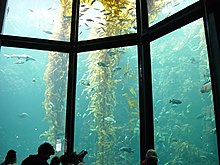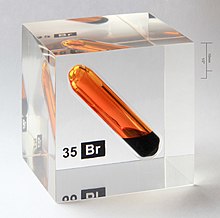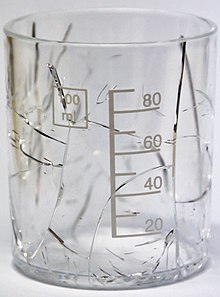Polymethyl methacrylate
| Structural formula | |||||||
|---|---|---|---|---|---|---|---|

|
|||||||
| General | |||||||
| Surname | Polymethyl methacrylate | ||||||
| other names |
|
||||||
| CAS number | 9011-14-7 | ||||||
| Monomer | Methacrylic acid methyl ester | ||||||
| Molecular formula of the repeating unit | C 5 H 8 O 2 | ||||||
| Molar mass of the repeating unit | 100.12 g mol −1 | ||||||
| Type of polymer |
Thermoplastic |
||||||
| properties | |||||||
| Physical state |
firmly |
||||||
| density |
approx. 1.18 to 1.19 g cm −3 |
||||||
| Glass temperature |
approx. 105 ° C |
||||||
| Water absorption |
0.3% in dry air |
||||||
| solubility |
not resistant to polar solvents such as B. acetone |
||||||
| Thermal expansion coefficient |
70–85 10 −6 K −1 for semi-finished products below the glass transition temperature |
||||||
| safety instructions | |||||||
|
|||||||
| As far as possible and customary, SI units are used. Unless otherwise noted, the data given apply to standard conditions . | |||||||
Polymethylmethacrylate ( abbreviation PMMA , and acrylic glass ) is a transparent thermoplastic plastic .
history
Acrylic glass was developed around the same time in Germany , Great Britain and Spain in 1928 . In Germany, the chemist Walter Bauer (1893–1968) was involved in this. The first cast acrylic glass panes were manufactured by Otto Röhm in Germany in 1933 and brought to market maturity. The first contact lenses from plastic were 1,940 Heinrich Wöhlk made of PMMA and applied self-experimentation - by this time there were only lenses made of polished silicate glass which had a significantly poorer fit. One of the first mainstream products of PMMA were covers of the Radio - record player combinations Braun SK 4 of the 1956th
Polymethyl methacrylate is now used in large quantities for a wide range of applications (see below).
Manufacturing
PMMA is routinely produced in a radical manner by substance , emulsion or suspension polymerisation. PMMA produced in this way is atactic and completely amorphous . An anionic polymerization (including methods of living polymerization ) of PMMA is also possible.
Synthesized by radical polymerization
The following reactions take place, for example, with dibenzoyl peroxide as initiator :
1. Radical formation
Since organic peroxides disintegrate homolytically when little heat is supplied, they are very suitable as radical generators. First, dibenzoyl peroxide is split before carbon dioxide (CO 2 ) is separated from the resulting radicals :
2. Chain start
The resulting radical now reacts with methyl methacrylate (MMA) to form a new, larger radical.
3. Chain growth
When the chain grows, the radical formed when the chain starts reacts again with the methacrylic acid methyl ester. This reaction happens again and again, so that an ever larger radical is created.
4. Chain termination
The chain growth can break off in different ways: two growing chains can meet and combine or disproportionate, or a growing chain can react with a starter radical. The first possibility is shown here:

Structure and properties
The pressure, temperature profile and duration of the polymerisation process have an influence on the average length of the resulting polymer chains and the crosslinking and entanglement of the polymer chains with one another. This, in turn, has a direct impact on some physical and chemical properties which, depending on the production process, may vary slightly from the values listed below.
PMMA burns crackling, with a yellowish flame, sweetish smell, dripping and without residue. When knocked on with your fingernail, PMMA does not sound tinny compared to transparent polystyrene because of its lower hardness.
PMMA is plastically deformable beyond 100 ° C and this deformation is thermally reversible . It enables good machining, can be cut or engraved very well with CO 2 lasers and is less sensitive to scratches than other thermoplastics . Connections by gluing or welding are possible. It transmits light better than mineral glass , is easy to color, weather and aging resistant, resistant to acids , alkalis of medium concentration, petrol and oil . However, ethanol , acetone and benzene attack PMMA. Therefore acrylic glass surfaces must not be cleaned with alcohol or solvents , otherwise stress corrosion cracking occurs. It absorbs UV light (apart from special UV-permeable variants for use in X-ray lithography or for solariums ).
The good weathering stability of the methacrylate polymers is due to the purely aliphatic structure and the steric shielding of the polymer chain.
If further monomers (alkyl or aryl methacrylates) are used in the polymerization, it is possible to adapt the properties of the copolymer to the product requirements. For example, the heat resistance or the glass transition temperature can be influenced by a suitable choice of the alcohol radical of the monomeric ester : Long-chain esters such as lauryl and stearyl methacrylates already show waxy polymer properties; Esters with a strongly branched alcohol residue produce polymers with a reduced solution viscosity. Are used in the copolymerization of multifunctional acrylates such as ethylene glycol , are used, be cross-linking PMMA copolymers obtained which have modified properties and z is. B. differ significantly in the flexural strength , the modulus of elasticity or the abrasion resistance and can thus be adapted to the respective purposes.
Copolymer combinations of anionic and cationic PMMA result in interpolyelectrolyte complexes (IPEC). They are preferably used to encase medicinal substances and to release them in a well-defined manner.
The design options are also very diverse. It can not only be used as a glass replacement for windows, but also for household items such as bowls .
Technical properties of PMMA:
- Thermal conductivity : 0.19 W / (m K)
- Specific heat capacity : 1.47 kJ / (kg K)
- Refractive index : 1.492 (for comparison: 1.45–1.9 for mineral glass )
- elastic, partially impact-resistant (however, there are specially reinforced variants)
- E-modulus (tensile): 2700-3200 N / mm²
- Dielectric strength : 35-40 kV / mm
- Tear strength : 70 N / mm²
- Permittivity at 50 Hz: 3.7
- Linear expansion coefficient per 1% water retention = approx. 0.001
use

Polymethyl methacrylate is used to manufacture a large number of transparent and non-transparent objects, goods , components , semi-finished products and semi-finished products for use in a wide variety of areas . PMMA is e.g. B. Indispensable in dentistry , where it is used for prostheses . For this purpose, the plastic is coated with various inorganic and organic pigments , such as B. titanium dioxide , various iron oxides or azo pigments , so that the typical pink color is created. In a transparent form, it is used for bandage splints. The plastic is freely mixed and hardens under heat and pressure. It is also possible to add activators which allow polymerization without an external increase in pressure and temperature.
Overview of important areas of application:
-
Industry and craft
- Automotive industry : indicator and taillight glasses, reflectors , light guides , door / pillar cladding in the exterior area (cladding for A / B / C pillars )
- Construction : polymer concrete , industrialfloors, glazing (e.g. double-walledsheets), for sealing and coating balconies and terraces, detail sealing in flat roofs , industrial door glazing (Plustherm system glazing), sanitary and furnishingcomponentse.g. B. for bathtubs, furniture, room dividers, door panels, lampshades, etc.
- Semiconductor industry : Use as a resist (photoresist) or a component thereof in photo and electron beam lithography for the production of circuits and printed circuit boards
- Lighting technology and optics : floodlight signs and "acrylic light design", luminaire covers ,illuminated advertising , sight glass, lenses , Fresnel lenses , optical fibers
- Aircraft construction : windows, hoods, headlight covers
- Machine protection : protective hoods and protective doors
- Model and prototype construction : as a mineral glass replacement for individual pieces and small series
- Pyrotechnics : part of delay sets
- Shipbuilding : submarine pressure hull, see also → Deep Rover DR1002
- Textile industry : component of copolymer fibers (polyacrylic), see also → polyacrylonitrile
- Watch industry : watch glass
-
medicine
- Ophthalmic optics : hard intraocular lenses , spectacle lenses
- Surgery :PMMA balls enrichedwith gentamicin, drawn up as chains for continuous antibiotic treatment
- Hearing aids - acoustics : ear molds ( otoplastics )
- Orthopedics : As in surgery for infections and as bone cement , e.g. B. for anchoring hip endoprostheses and for augmentation, for example, kyphoplasties for the treatment of fractures
- Dentistry: ( see above ) full and partial dentures , temporaries , occlusal splints , braces , crowns and bridges as well as artificial teeth
-
Other products or areas of application
- Fine arts : As a material and image carrier
- Photography : Direct photo printing (mostly according to CMYK color model ) on the back of the acrylic glass (acrylic glass photo)
- Horticulture: For example, for roofing and side panels of greenhouses
- Household goods: bowls, housings, containers, salad spoons, salt and pepper mills
- Adhesives: methyl methacrylate adhesive for joining metals and plastics
- Musical instruments : drums , piano key pads ; also clarinets , flutes , oboes , bassoons
- Smokers' goods : For the production of water pipes , so-called acrylic bongs
- Jewelry: So-called plugs and other jewelry for e.g. B. widened piercings .
-
Material for laser cutter
- Sheets of extruded acrylic are better for cutting, and sheets of cast acrylic are better for engraving.
Brand and trade names

Polymethyl methacrylate (PMMA) became known under the trade name Plexiglas , registered in 1933 by Otto Röhm . In Europe and Asia, Plexiglas is a registered brand name of Röhm GmbH , in the USA it is Altuglas International ( Arkema Group). However, Röhm also sells its acrylic glass in the USA under the name Acrylite® .
In Europe, the Altuglas International Group markets PMMA under the name Altuglas ; Arkema Group PMMA under the name Oroglas .
Polymethyl methacrylate is also known colloquially as acrylic glass or O-glass. O-glass was the brand name of the material in the GDR (for "organic glass"). The only manufacturer was the Piesteritz nitrogen works . The trade name Piacryl is derived from "Piesteritz" .
There are a number of other proprietary trade names, including Biacryl , Conacryl , Deglas , deacon , Friacryl , Hesaglas , hesalite , Hesalite , Limacryl , PerClax and vitroflex .
recycling

The recycling code for polymethyl methacrylate is 07.
See also
Other plastics for transparent applications:
- CR-39 (glasses)
- Polycarbonate (often used in light panels )
- Polyethylene terephthalate (PET)
- Polypropylene (PP)
- Polyvinyl chloride (PVC)
literature
- Kai Buchholz, Ralf Beil (ed.): Plexiglas®. Material in Architecture and Design (on the occasion of the exhibition Plexiglas, Material in Architecture and Design. Institut Mathildenhöhe Darmstadt, Museum Künstlerkolonie, September 16, 2007 - January 6, 2008. Translated by RAG Service, Sprachendienst). Wienand, Cologne 2007, ISBN 978-3-87909-925-2 .
Web links
- Trade names and manufacturers of polymethyl methacrylate
- Comprehensive key data about PMMA in the REVIETA material database
Individual evidence
- ^ Wolfgang Kaiser, Kunststoffchemie für Ingenieure , 3rd edition, Carl Hanser, Munich, 2011, pp. 353f.
- ^ A b c Wolfgang Kaiser: Kunststoffchemie für Ingenieure , 3rd edition, Carl Hanser, Munich, 2011, 339ff.
- ↑ a b PMMA XT. Acrylic glass extruded. (PDF; 32 kB) In: Technical data sheet. Amsler & Frey AG (Schinznach-Dorf), August 1, 2016, p. 1 , accessed on April 5, 2018 .
- ↑ a b c Properties of plexiglass. GS / XT. In: plexiglas.de. Evonik, accessed April 5, 2018 .
- ↑ How great is the thermal expansion of acrylic? with online calculation. In: pmma.dk. Induflex (Stvring, Denmark), accessed April 5, 2018 .
- ↑ Alexander Unger: Term: coefficient of thermal expansion. Data from the book A. Unger: Fussboden-Atlas 2011. In: fussbodenatlas.de. Unger, accessed April 5, 2018 .
- ↑ This substance has either not yet been classified with regard to its hazardousness or a reliable and citable source has not yet been found.
- ↑ Company - History. Wöhlk Contactlinsen GmbH, accessed on March 26, 2018 .
- ^ Rauch Puntigam, Theodor Volker: Acrylic and methacrylic compounds . In: Springer Verlag Berlin (ed.): Chemistry, physics and technology of plastics in individual representations . tape 9 . Springer Verlag, 1967, ISBN 978-3-642-46058-6 , pp. 208 ff .
- ^ Diego Gallardo, Brigitte Skalsky, Peter Kleinbudde: Characterization of combinations between anionic-cationic poly (methyl methacrylate) copolymers. In: Die Pharmazeutische Industrie , Volume 73, No. 10, 2011, pp. 1875-1884.
- ↑ a b Degussa Röhm Plexiglas product description, identification no. 211-1, Feb. 2003.
- ^ Philipp Gellius: Musical instruments made of plexiglass. : Signals for the musical world , year 1938, p. 479f. (Online at ANNO ).
- ^ History on plexiglas.de
- ↑ Registered 2006-05 as a community trademark under number 003739505
- ^ Altuglas International .
- ↑ Oroglas .






